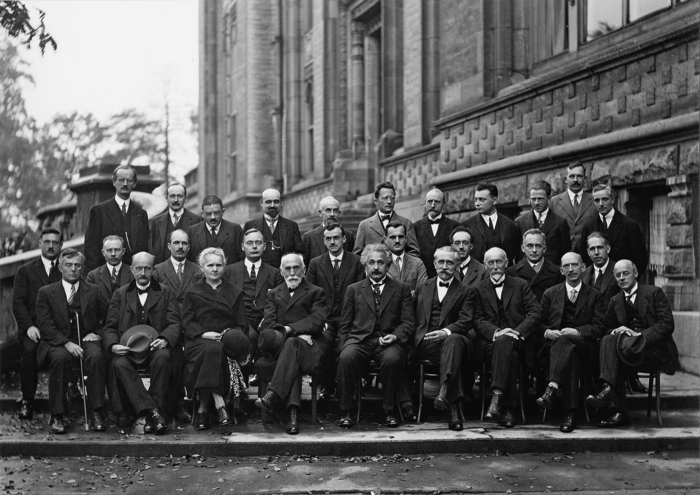[Vienna, October 10 2022] — The year was 2018 and physicist Fariba Karimi remembers feeling appalled and disgusted by the remarks made by a prominent male scientist during a presentation at Cern, the European nuclear research center in Geneva. “It was just unbelievable,” recalls Karimi, who leads a team in computational social science at the Complexity Science Hub Vienna (CSH).

Credit: Photograph by Benjamin Couprie, Institut International de Physique Solvay, Brussels, Belgium
[Vienna, October 10 2022] — The year was 2018 and physicist Fariba Karimi remembers feeling appalled and disgusted by the remarks made by a prominent male scientist during a presentation at Cern, the European nuclear research center in Geneva. “It was just unbelievable,” recalls Karimi, who leads a team in computational social science at the Complexity Science Hub Vienna (CSH).
During a Cern workshop on gender equality, a professor of Pisa University said physics was “invented and built by men” and claimed that male scientists produced better research than female researchers.
The controversy spurred Karimi, who has long been intrigued with the origins of gender disparities in STEM (science, technology, engineering, and mathematics) fields, to design a study to discover why women are discriminated against in physics.
Her findings are published in the new issue of the journal Communications Physics.
First-mover advantage
The study, which drew on a unique dataset provided by the American Physical Society, confirmed that women are still largely underrepresented in this field. However, the results indicate that, although papers written by women tend to have lower visibility, the gender gap is the result of men enjoying a first-mover advantage in physics.
“This means that the participation of men in physics has historically been disproportionately higher than that of women. It also means that the entry barrier for women into physics was higher – due to sexism and societal expectations of women – and therefore they could not enter the physics community as early as men,” explains Karimi.
“At a macro level, this structural barrier resulted in a physics community with more senior privileged white men, thus creating an illusion that physics is not for women,” adds the CSH researcher.
Recognition for similar work
The dataset was composed of more than 541,000 scholarly articles published between 1893 to 2010, and included article metadata, author information, and citations. Using a technique that combines name and image recognition, the researchers inferred the gender of the primary authors of papers: 9,947 women and 60,886 men.
“In the study, rather than just comparing men and women in physics in terms of publications and citations, I wanted to see whether they receive different recognition for similar work published around the same time,” points out the CSH’s team leader.
Consequently, the team selected pairs of papers on similar topics written by men and women primary authors. Then, they computed the difference in the number of citations each paper received. “The main goal was to compare pairs of similar papers in an unbiased fashion,” explains Hyunsik Kong, co-author of the study.
By comparing “apples to apples,” the researchers came upon a disparity in citations. “It’s not huge, but it’s definitely there”, observes Samuel Martin-Gutierrez, co-author of the paper and a postdoc at CSH. “And we found that the temporal aspect of scientific production was very important to explain this citation disparity.”
Men still have the edge over women
According to the analysis, whoever published first, regardless of gender, tended to get most of the attention of the scientific community. “This explains part of this disparity, but not all. There are differences in how men and women get the first-mover advantage and men still have the edge over women,” says Martin-Gutierrez.
In other words, this means that men tended to publish first more often than women. Furthermore, when men published first, they still gained an advantage over women. “A male author gets more citations when he publishes first compared to a female author,” points out Martin-Gutierrez.
When the CSH team adjusted the time of publication, there were no statistically significant differences in citations of men and women. “The results combined suggest that the overall disparity in the citation network is a result of cumulative advantages and the first-mover effect that men have in physics,” conclude the scientists.
“From a broader perspective, the entry barriers for women due to historical disadvantages and sexism create a so-called ‘structural inequality’ or what sociologists call ‘racism without racists’. As a result, structural inequality continues to affect women’s participation for generations to come, and it should be addressed through appropriate interventions,” highlights Karimi.
The study “Influence of the first-mover advantage on the gender disparities in physics citations,” by Hyunsik Kong, Samuel Martin-Gutierrez, and Fariba Karimi, was published in Communications Physics (2022) 5:243.
About CSH
The mission of the Complexity Science Hub Vienna is to host, educate, and inspire complex systems scientists dedicated to making sense of Big Data to boost science and society. Scientists at the Hub develop methods for the scientific, quantitative, and predictive understanding of complex systems.
The CSH is a joint initiative of AIT Austrian Institute of Technology, Central European University CEU, Danube University Krems, Graz University of Technology, IIASA, Medical University of Vienna, TU Wien, VetMedUni Vienna, Vienna University of Economics and Business, and Austrian Economic Chambers (WKO). https://www.csh.ac.at
Journal
Communications Physics
DOI
10.1038/s42005-022-00997-x
Method of Research
Data/statistical analysis
Subject of Research
People
Article Title
Influence of the first-mover advantage on the gender disparities in physics citations
Article Publication Date
13-Oct-2022
COI Statement
The authors declare no competing interests.




